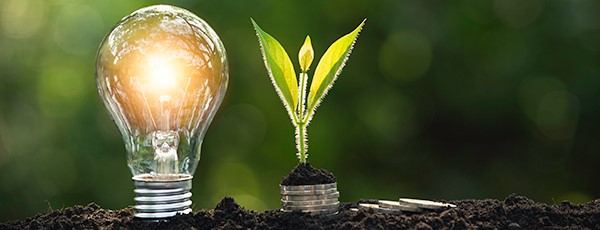Climate Change
Climate Change Countermeasure Targets
*3 SBTs (Science Based Targets): CO2 emissions reduction targets based on scientific data

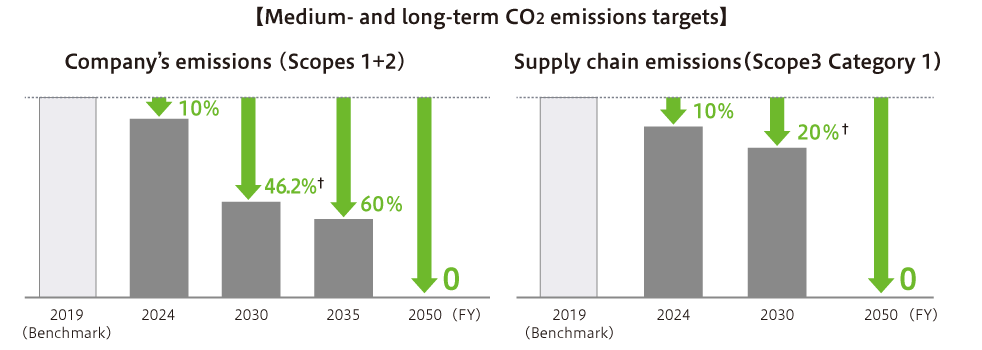
Climate Change Initiatives
Establishment of new medium- and long-term targets
Reducing our Scopes 1 and 2 emissions
To achieve our FY2030 target, we promote various energy-saving and low-carbon measures, such as introducing and updating highly energy-efficient equipment. We also work to reduce CO2 emissions by gradually introducing renewable energy-derived electricity to SHIONOGI’s major sites, such as plants and research laboratories. Although the FY2023 target was a 15% reduction in Scopes 1+2 CO2 emissions compared to FY2019, the actual reduction was only 12.4%. The main reason for not achieving the target was an unexpected deterioration in the emission factor (electricity) at major operating sites. Meanwhile, SHIONOGI’s overall energy consumption before multiplying by the emission factor was at a level that would allow us to achieve the target, partly due to the introduction of renewable energy-derived electricity.
Although we have not achieved our FY2023 target (annual target), by bringing forward the introduction of renewable energy-derived electricity to the Shionogi Pharmaceutical Research Center (SPRC), we have achieved our FY2024 target set in the SHIONOGI Group EHS Action Targets in FY2023, ahead of schedule.
As for our efforts to reduce Scope 2 CO2 emissions through the use of renewable energy-derived electricity, in FY 2023, we introduced renewable energy-derived electricity to the Shionogi CMC Research Innovation Center (CRIC) in addition to the SPRC mentioned above, in accordance with the introduction plan for SHIONOGI’s major sites. With this, we have completed the introduction of renewable energy-derived electricity to the major sites of Shionogi & Co., Ltd., including the head office building and the Aburahi Research Center, which have already completed its introduction, significantly increasing SHIONOGI’s overall introduction rate to 40.8%. Going forward, we will promote the introduction of renewable energy-derived electricity to the plants of Shionogi Pharma Co., Ltd., which is responsible for SHIONOGI’s manufacturing functions. We plan to complete its introduction to all major sites by 2030.
Plan for introducing electricity derived from renewable energy
Fiscal year of introduction |
Site |
Company name |
Status |
|---|---|---|---|
FY2021 |
Head Office |
Shionogi & Co., Ltd. |
Completed |
FY2022 |
Aburahi Research Center |
Shionogi & Co., Ltd. |
Completed |
FY2023 |
Shionogi CMC Research Innovation Center Shionogi Pharmaceutical Research Center (SPRC) |
Shionogi & Co., Ltd. |
Completed |
Amagasaki Office |
Shionogi Pharma Co., Ltd. |
Completed |
|
FY2024 |
Settsu Plant |
Shionogi Pharma Co., Ltd. |
Scheduled |
FY2025 |
- |
- |
- |
FY2026 |
Tokushima Plant |
Shionogi Pharma Co., Ltd. |
Scheduled |
FY2027 |
Kanegasaki Plant |
Shionogi Pharma Co., Ltd. |
Scheduled |
FY2028 |
Yokohama Research Center, Akita Plant |
UMN Pharma Inc. |
Scheduled |
FY2029 |
Itami Plant |
Shionogi Pharma Co., Ltd. |
Scheduled |
FY2030 |
Nanjing Plant |
Nanjing Chang’ao Pharmaceutical Co., Ltd. |
Scheduled |
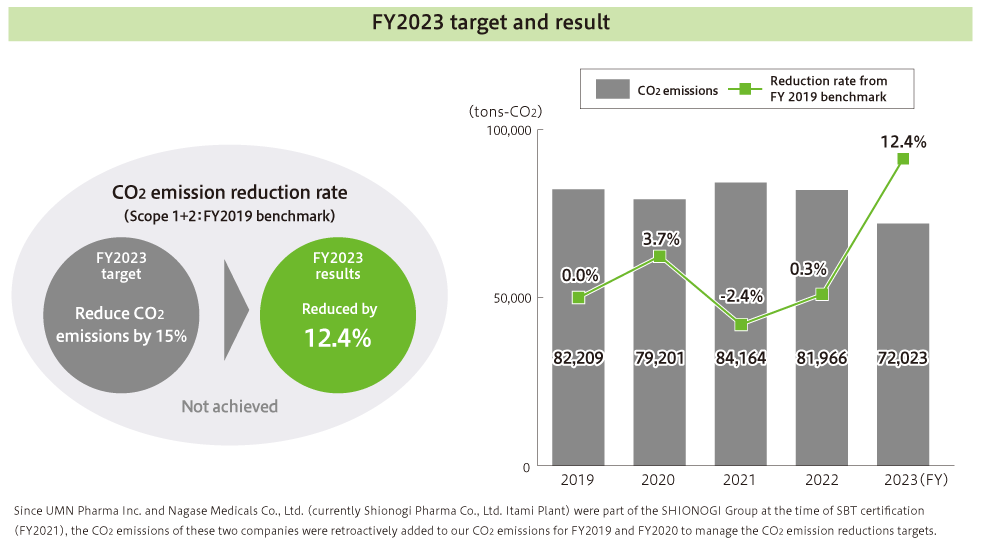
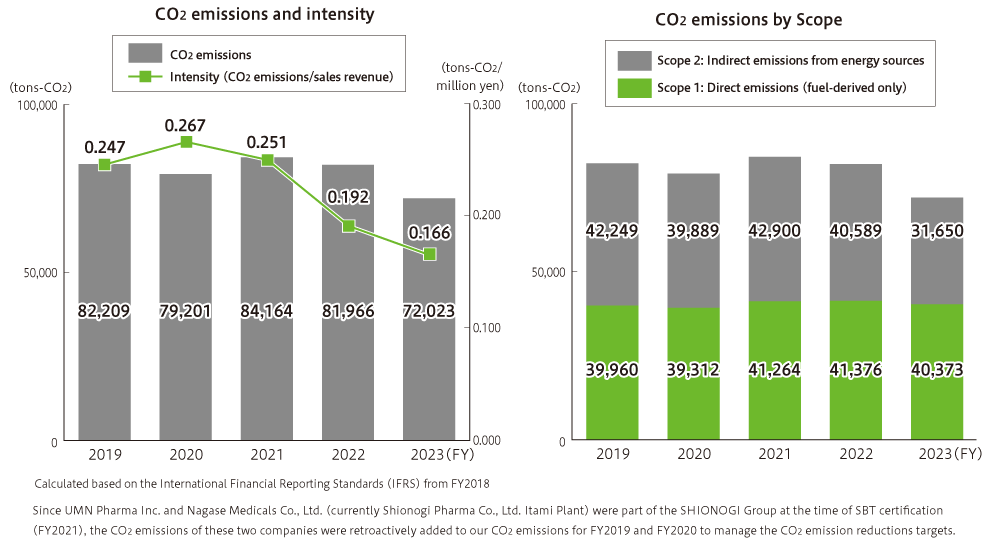
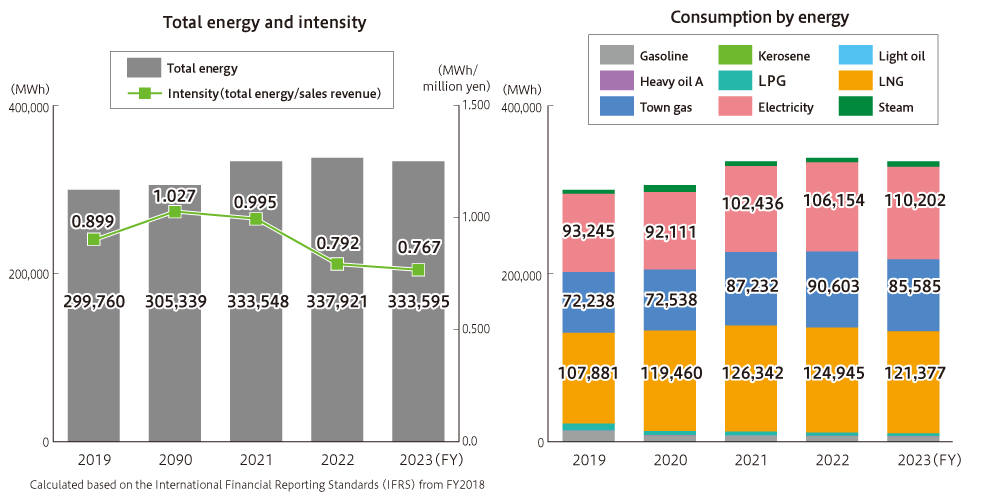
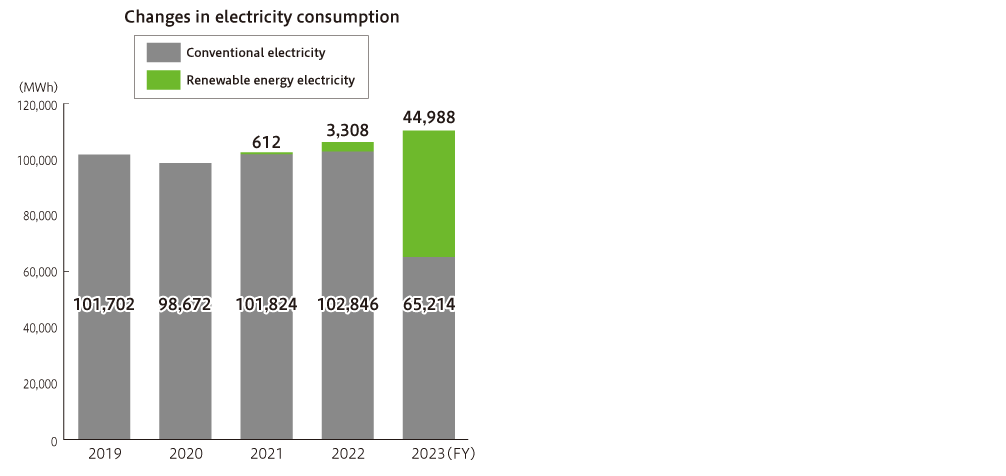
Vehicles for sales activities
Due to the spread of the COVID-19 pandemic and the promotion of DX in medical information provision activities, the proportion of medical representatives (MRs) working remotely is increasing. Consequently, fuel consumption by vehicles for sales activities remained lower in FY2023 than in FY2019, before the spread of COVID-19.
As for the reduction of CO2 and exhaust gas emissions by converting vehicles loaned to MRs to hybrid vehicles, we have completed the conversion of all vehicles for sales activities to hybrid vehicles by FY2022.
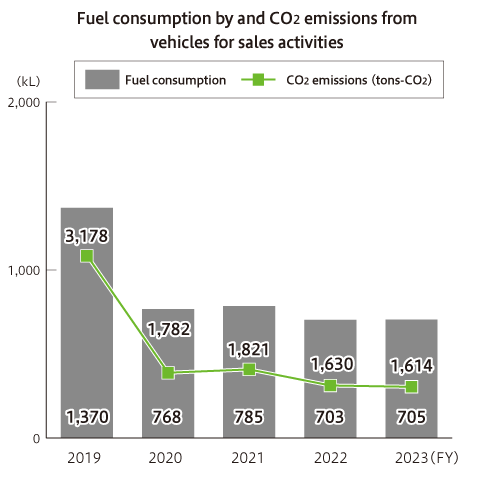
Reducing our Scope 3 emissions
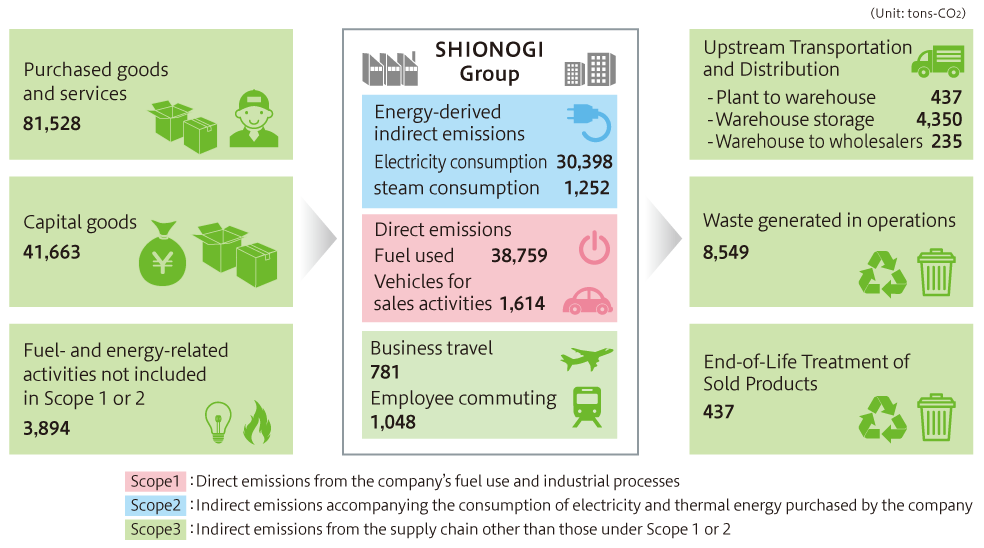
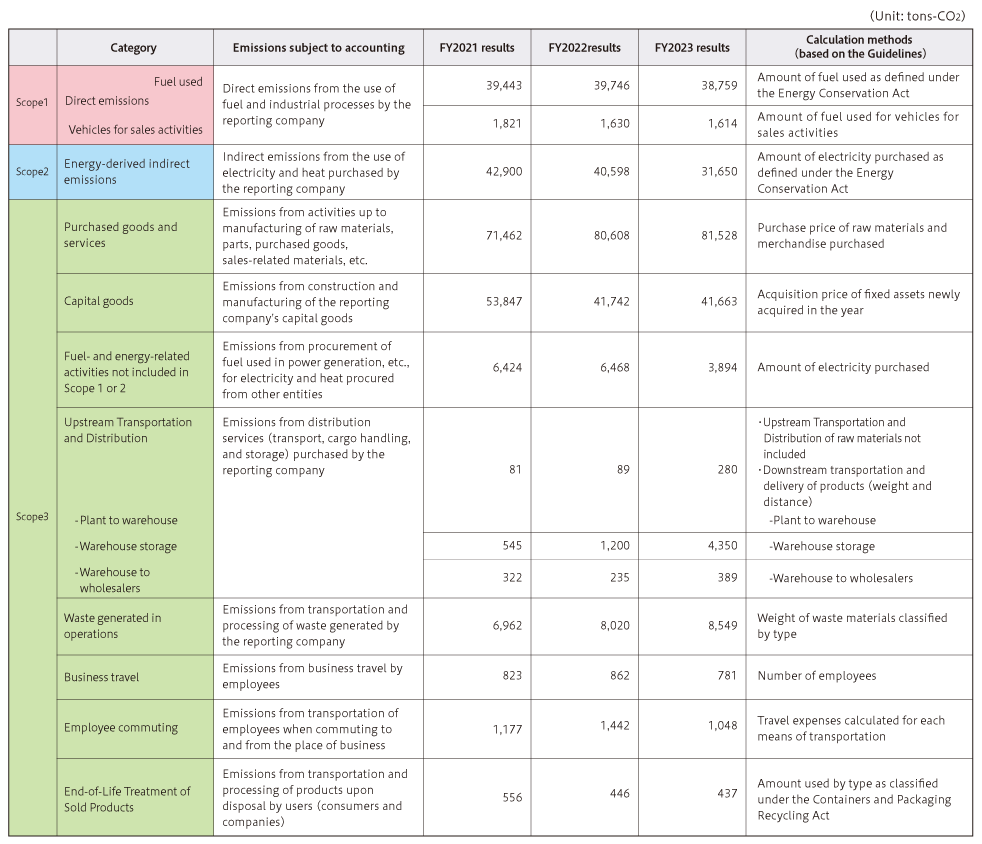
The emissions for each category of Scope 3 are calculated using the “Basic Guidelines on Accounting for Greenhouse Gas Emissions Throughout the Supply Chain (Ver.2.6)” of the Ministry of the Environment and the Ministry of Economy, Trade and Industry of Japan. Since FY2022, CO2 emissions in Categories 1 and 2 of Scope 3 have been calculated using the emission intensity based on prices including consumption tax. In line with this, GHG emissions in FY2021 have been recalculated using the emission intensity based on prices including consumption tax.
In FY2021, SHIONOGI participated in the Model Project for Supporting Achievement of the Decarbonization Targets of the Entire Supply Chain, a project of the Ministry of the Environment aimed at helping companies achieve their GHG emissions reduction targets for the entire supply chain. Based on the CO2 emissions reduction measures for the entire supply chain formulated in the project, we are building a collaborative system, including Group companies, to promote supplier engagement, and implementing a supply chain engagement process.*4
In FY2023, we conducted supplier engagement activities for our top 15 suppliers by purchase amount, including holding briefing sessions to promote their understanding of SHIONOGI’s policy on climate change, checking the status of their efforts to reduce CO2 emissions (questionnaire), and holding study sessions on calculating Scope 3 emissions to support them. In the future, we will select more significant suppliers for CO2 emissions reduction to ask them to reduce their CO2 emissions, and support their efforts on a priority basis.
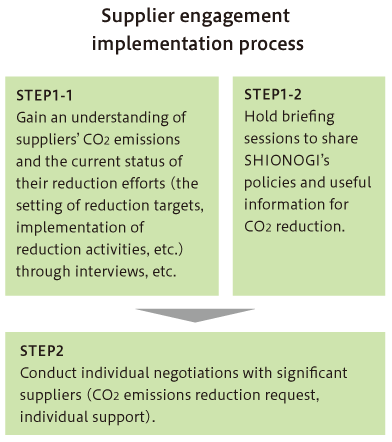
External activities for addressing climate change
Selected as an A List Company for the Second Consecutive Year in CDP Climate Change 2023
In the Climate Change Report 2023 published by CDP,*5 an international non-profit organization that addresses environmental information disclosure, we received the highest rating of A.
Isao Teshirogi, Representative Director, President and CEO of SHIONOGI, delivered a speech at the CDP Awards Japan 2024 on SHIONOGI’s initiatives as a double-A company in “Climate Change 2023” and “Water Security 2023.” In the speech, he expressed SHIONOGI’s intention to promote business transformation to create new healthcare solutions and deliver them globally, and at the same time to grow as a company needed by society while realizing a sustainable society through efforts to preserve the global environment.
Speech video (CDP Awards Japan 2024) (External website)
Speech video (Message from the executives of A List Companies) (External website)
*5 CDP
CDP is a non-profit organization whose main activities involve requesting companies and local governments to disclose information on their actions for climate change control, water resource protection, forest conservation, and other environmental issues based on the request of institutional investors and major corporate clients around the world with a strong interest in environmental issues, thereby promoting actions to tackle environmental issues. CDP is now one of the world’s most useful information disclosure platforms on environmental issues.
Support for the messages from the Japan Climate Initiative (JCI)
The Japan Climate Initiative (JCI) is a network aimed at realizing a decarbonized society by enhancing information dissemination from and exchange of views between companies, local governments, and NGOs that are actively involved in climate change initiatives in Japan. SHIONOGI participated in the JCI in April 2021. As a member company, SHIONOGI expresses its support for all five messages/proposals published by the JCI to the Japanese government.
“JCI’s Message: JCI calls on the Japanese government to set an ambitious 2035 target that is consistent with the 1.5-degree goal” (External website)
With medium- and long-term targets, including its SBTs, SHIONOGI is working daily to reduce its CO2 emissions. We strongly support the JCI message since it is consistent with SHIONOGI’s decarbonization policy, which aims to be carbon neutral by 2050.
Our efforts to combat AMR, which could spread further due to climate change
SHIONOGI’s efforts against AMR (antimicrobial resistance) are presented on the website “Climate Change Adaptation Information Platform (A-PLAT)” operated by the National Institute for Environmental Studies, Japan.
See the section “AMR” for more information on SHIONOGI’s AMR initiatives.
Shionogi & Co., Ltd. | Examples of adaptation business | Adaptation for Private Sector | Climate Change Adaptation Information Platform (A-PLAT) (nies.go.jp) (External website)

